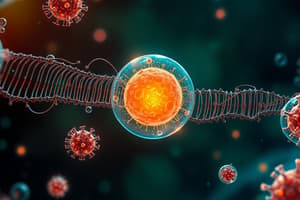Podcast
Questions and Answers
What is the primary function of ribosomes within a eukaryotic cell?
What is the primary function of ribosomes within a eukaryotic cell?
- Energy production
- Synthesis of proteins (correct)
- Storage of genetic material
- Modification of secretory products
Which organelle is primarily responsible for packaging and sorting secretory products?
Which organelle is primarily responsible for packaging and sorting secretory products?
- Nucleus
- Mitochondria
- Golgi apparatus (correct)
- Endoplasmic reticulum
Which term best describes the study of cellular structures and their functions?
Which term best describes the study of cellular structures and their functions?
- Cytology (correct)
- Histology
- Biochemistry
- Pathology
What is the function of the endoplasmic reticulum in a eukaryotic cell?
What is the function of the endoplasmic reticulum in a eukaryotic cell?
Which structure is crucial for the stabilization of ribosomal structure?
Which structure is crucial for the stabilization of ribosomal structure?
What major role does the cytoskeleton play in a eukaryotic cell?
What major role does the cytoskeleton play in a eukaryotic cell?
Which of the following is a component of the cell membrane?
Which of the following is a component of the cell membrane?
What process is primarily facilitated by the Golgi apparatus?
What process is primarily facilitated by the Golgi apparatus?
What is a primary function of the Rough Endoplasmic Reticulum (RER)?
What is a primary function of the Rough Endoplasmic Reticulum (RER)?
Which of the following is NOT a function of the Smooth Endoplasmic Reticulum (SER)?
Which of the following is NOT a function of the Smooth Endoplasmic Reticulum (SER)?
What is the primary role of lysosomes?
What is the primary role of lysosomes?
Which of the following statements about mitochondria is correct?
Which of the following statements about mitochondria is correct?
Which organelle assists in the oxidation of fatty acids?
Which organelle assists in the oxidation of fatty acids?
What type of enzymes do lysosomes contain?
What type of enzymes do lysosomes contain?
How is mitochondrial DNA inherited?
How is mitochondrial DNA inherited?
Which best describes the outer membrane of mitochondria?
Which best describes the outer membrane of mitochondria?
Flashcards are hidden until you start studying
Study Notes
Dr Katja Vogt - Cell Biology
- Dr Katja Vogt is a lecturer in Medical Sciences at the University of Central Lancashire (UCLan)
- Her email address is [email protected]
Cell Structure and Function
- The course covers:
- Components of the cell
- Structure and function of major cell organelles
- Cell cytoskeletons
- Importance of cellular trafficking
The Cell
- Cells come in many forms and shapes
The Eukaryotic Cell
- Contains:
- Cell membrane
- Nucleus
- Ribosomes
- Endoplasmic reticulum
- Golgi
- Centriole
- Mitochondria
Ribosomes
- Ribosomes are composed of a large (60S) and a small (40S) subunit
- Ribosomal structure is stabilized by rRNA
- Ribosomes are produced and assembled in the nucleolus
- Function: Protein synthesis
Golgi Apparatus
- Functions:
- Polysaccharide synthesis
- Modifying secretory products
- Sorting secretory products
- Packaging secretory products
- Concentrating and storing secretory products
Endoplasmic Reticulum (ER)
- Function: Synthesizes, packs, and processes various molecules
- Two forms:
- Rough ER (RER)
- Sequesters proteins from the cytoplasm
- Involved in the synthesis of:
- Secretory proteins
- Integral membrane proteins
- Lysosomal enzymes
- Core glycosylation
- Smooth ER (SER)
- Involved in:
- Lipid metabolism
- Steroid hormone synthesis
- Gluconeogenesis
- Detoxification
- Involved in:
- Rough ER (RER)
Vesicles
- Granules:
- Are vesicles destined for exocytosis
- Abundant in specialized secretory cells
- Lysosomes:
- Have a pH of 5
- Contain hydrolytic enzymes
- Degrade material
- Peroxysomes:
- Participate in hydrogen peroxide metabolism
- Assist in fatty acid oxidation
Mitochondria
- The power-house of the cell
- Structure:
- Contains its own DNA (mtDNA), which is maternally inherited.
- Has an outer membrane permeable to molecules
- Functions:
- Synthesizes its own DNA and some proteins.
- Grows and reproduces.
- Can move rapidly and change shape.
Studying That Suits You
Use AI to generate personalized quizzes and flashcards to suit your learning preferences.




